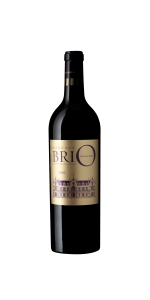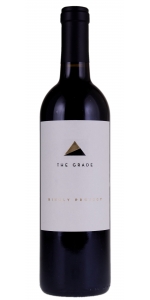Cantenac Brown Brio de Cantenac Brown Margaux 2010
| Country: | France |
| Region: | Bordeaux |
| Winery: | Cantenac Brown |
| Grape Type: | Cabernet Sauvignon |
| Vintage: | 2010 |
| Bottle Size: | 750 ml |
A new wine for the new century: BriO de Cantenac Brown was born in 2001.
Through the style of its label, but also through the quality of our work from the selection of the lots to the bottling, it aims at expressing the modernity of our Château.
The lots supposed to be the main part of BriO are pre-selected because of their evolution all through the year, which means that we focus on each different lot of the winery, from the budburst through the flowering to the ripeness control.
A meticulous attention
The lots for BriO often need more work: more leaf pruning, some green harvest, for example on the young vines, to help them to deal with the weather conditions.
Our two labels are made from vines located on a beautiful terroir where you find gravelly soils, and we want the vinification of BriO to lead to an elegant wine with lots of flavours, a compromise between strength and finesse.
So, if you like the fruits, you can start to drink it from 2 to 5 years after the harvest.
The blend between Cabernet Sauvignon, Cabernet Franc and Merlot is different for each vintage but the Merlot percentage is usually more important than the one in the Château Cantenac Brown.
The 12 months-long ageing in 20% to 25% new oak barrels is traditional; we rack it every 3 months. Before the bottling, we do the fining with egg whites.
It is on purpose if the bottles of BriO are different from the ones of Cantenac Brown: we want BriO to become a brand on its own, and it’s true that we talk much more about “BriO” than about “BriO de Cantenac Brown”.
We want BriO to be a wine you drink before, during and after a meal; just for your pleasure.
The Grade Cellar Kingly Project Cabernet Sauvignon is made from Napa Valley Cabernet Sauvignon.
"This is a noble expression of Cabernet Sauvignon" in full regalia, with decadent aromas and a mouthfeel viscous and sleek. "This vintage of the Kingly Project Cabernet Sauvignon enters the scene" -- Thomas Rivers Brown
Review:
The 2018 Cabernet Sauvignon Kingly Vineyard is endowed with tremendous richness and concentration. It emerges from the best spots within Block 5, which is a bit more protected from the elements. The 2018 is a bit closed today, but it has a lot of promise. Time in the glass brings out layers of inky dark fruit and the savory, minerally notes that are such signatures. This potent Calistoga Cabernet needs time to shine, but it is impressive today just the same.
-Vinous 96 Points
The Grade Napa Cabernet Sauvignon Winfield Vineyard is made from Napa Valley Cabernet Sauvignon.
“This wine expresses a focused balancing act of dark, rich black fruit, and a fine tannin structure, illuminated through the core with a laser-like acidity. The wine displays a deep purple-red hue with a cranberry halo. Aromas of cassis, cinnamon, citrus oil, roasted meat, and lilac swell from the glass.
“The palate is marked by a wave of jet-black brambly fruit up front, followed by an exotic spice mid-palate and a long, complex finish that lasts and lasts expressing notes of flowering jasmine, and oolong tea. The silky tannins hold everything together and will certainly allow this wine to evolve in the cellar for at least 7-10 years.” - Thomas River Brown
Review:
The 2018 Cabernet Sauvignon Winfield Vineyard is an absolutely gorgeous wine that conveys a striking interplay of richness, power and nuance. Silky and restrained for this site, the Winfield offers up a compelling melange of red fruit, iron, cedar, tobacco, rose petal and dried herbs, all in a mid-weight style that is incredibly appealing. The Winfield is a selection taken from Blocks 1, 4 and 5.
-Vinous 94 Points
It has a brownish red color. Intense and complex, aged for many years in French oak. It has an elegant cigar leaf aroma. Dense and round in the mouth with dried fruit, honey and notes of crystallized fruit. A velvety and persistent finish.
RS: 114g/Liter
TA: 3.7g/Liter
No irrigation, Harvest by hand, Port wine traditional method: (Fermentation, with skin maceration, takes place a a controlled temperature and is interrupted by the addition of grape spirits).
Aged in 550 Liters French Oak barrels with an average age of 40 years.
Slightly filtered before bottling.
Pairings: Digestive: Dried fruits, caramel sweets and conventual sweets (portugueuse pastries)
Ormes de Pez Saint Estephe is made from 54% Merlot, 38% Cabernet Sauvignon, 4% Cabernet Franc and 4% Petit Verdot.
Château Ormes de Pez 2020 displays deep garnet-purple color with notes of plum preserves and dark berries, plus hints of graphite. Nice chewiness to the texture and lovely freshness, finishing on a lingering fragrant-earth note.
All older vintage wines have been purchased from a single collectors cellar. Pictures can be requested before shipment.
A new wine for the new century: BriO de Cantenac Brown was born in 2001.
Through the style of its label, but also through the quality of our work from the selection of the lots to the bottling, it aims at expressing the modernity of our Château.
The lots supposed to be the main part of BriO are pre-selected because of their evolution all through the year, which means that we focus on each different lot of the winery, from the budburst through the flowering to the ripeness control.
A meticulous attention
The lots for BriO often need more work: more leaf pruning, some green harvest, for example on the young vines, to help them to deal with the weather conditions.
Our two labels are made from vines located on a beautiful terroir where you find gravelly soils, and we want the vinification of BriO to lead to an elegant wine with lots of flavours, a compromise between strength and finesse.
So, if you like the fruits, you can start to drink it from 2 to 5 years after the harvest.
The blend between Cabernet Sauvignon, Cabernet Franc and Merlot is different for each vintage but the Merlot percentage is usually more important than the one in the Château Cantenac Brown.
The 12 months-long ageing in 20% to 25% new oak barrels is traditional; we rack it every 3 months. Before the bottling, we do the fining with egg whites.
It is on purpose if the bottles of BriO are different from the ones of Cantenac Brown: we want BriO to become a brand on its own, and it’s true that we talk much more about “BriO” than about “BriO de Cantenac Brown”.
We want BriO to be a wine you drink before, during and after a meal; just for your pleasure.
Technical Data
Vineyard: 48 Ha
Grape varieties:
65% Cabernet Sauvignon
30% Merlot
5% Cabernet Franc
Vinification: in temperature controlled stainless steel vats
Ageing: 12 months
20% to 25% new oak barrels
Review:
This is a muscular wine, with some yummy fleshy fruit underneath the tannins. Juicy and enticing already. Lots of blueberry character. Excellent for a second wine. 91 to 92 Points James Suckling
Cantenac Brown Estate
Grand Cru Classé in 1855
At the beginning of the 19th century, John-Lewis Brown (1769-1851), bought a vineyard and designed in the village of Cantenac, a traditional Tudor style château, reminding him of his Scottish origins. His name is forever linked to the Grand Cru Classé. His grandson, John-Lewis Brown (1829-1890) esteemed animal painter and “Chevalier de la Légion d’Honneur”, spent time there during his childhood.
In 1843, Mr. Gromard, banker, took over the estate. After the 1855 Grand Cru Classification, Louis Armand Lalande (1820-1894), Bordeaux winemerchant and owner of several estates in Médoc, extended the building. Surrounded by a remarkable British style park, Château Cantenac Brown is since then among the most original in Médoc.
In 2006, the Simon Halabi family has given new impetus to the estate with the ambition of raising it to the highest echelons.
José Sanfins presently manages Château Cantenac-Brown. He does his utmost to make the best of the magnificent terroir, lavishing the greatest of care on the soil and the vines, with great respect for the environment.
This meticulous attention to detail continues into the cellar, where everything possible is done to produce an exceptional wine.
John-Lewis Brown (1769-1851) acquired the estate in the early 19th century and decided to build in the village of Cantenac, a Tudor style chateau reminiscent of his Scottish origins.
The building is one of the most unusual in Médoc region and is surrounded by a remarkable English-style ground.
The quality of the wine was acknowledged in the 1855 classification, when Château Cantenac Brown was included into the growths.
The Bordeaux winemerchant and owner of several estates in Médoc, Louis Armande Lalande (1820-1894), extended the building, keeping the same architecture.
One hundred fifty years later, the Simon Halabi family has given a new impetus to this estate with a British atmosphere
…which they are determined to raise to the very highest level.
José Sanfins presently manages Château Cantenac-Brown. He does his utmost to make the best of the magnificent terroir, lavishing the greatest of care on the soil and the vines, with great respect for the environment. This meticulous attention to detail continues into the cellar, where everything possible is done to produce an exceptional wine.
Cantenac Brown Vineyards
With José Sanfins in charge, methods have changed.
The vineyard is managed in a more environmentally friendly way: the “sustainable approach” goes without saying.
The vines are cared for throughout the year and yields are perfectly controlled.
Strictly plant-based fertilizers are applied in a moderately and balanced way in tune with the needs of the vines.
This respect for Nature explains why the Château Cantenac Brown team continues to use the traditional soil maintenance techniques, which gradually enhance the structural, chemical and biological properties of the earth.
“A perfect match between Men and Nature…”
Over 400 000 vinestocks are managed every year. Pruning, removal of buds, leaves and secondary shoots, hand harvest …, several times per year the whole team works vine by vine and checks each single cluster.
Such a sharp selection does not replace the environment. The finest wines are given by the Nature.
- back
The Special Club concept started in 1971. A dozen wine growers from some old families of Champagne had an idea to familiarize people with the originality of the “Champagne de Vigneron” (Champagne of wine grower), thanks to prestigious vintages.
In the beginning, they created an association called the “Club des Viticulteurs Champenois” and chose a bottle with a special shape, created exclusively for them & used only by then. In 1988, they changed the bottle and the label. In 1999, the Club changed its name to “Club Trésor of Champagne.”
The Club Trésors comprises 28 artisan wine makers, selected from the finest areas of the Champagne region, each one recognized for the quality of their work. The Club Trésors is the only organization in Champagne to select its members according to a set of unrelenting quality standards:
- Each wine maker must make their champagnes entirely in his, or her, own premises and cellars. Furthermore, the champagne must be made exclusively from grapes harvested in his, or her, own vineyards.
- Each wine maker is devoted to his work and passionately protects the quality and the unique character of his own terroir.
- The jury of oenologists and wine professionals who select the champagnes demand irreproachable quality in both the work in the vineyard and the wines.
- Each champagne is subject to two blind tastings (once at the still wine stage before bottling and again after 3 years ageing in bottle) by a panel of passionate and distinguished oenologists and wine makers. 4 years aging minimum is required.
- A Special Club champagne may only be made in outstanding vintage years.
Roland Champion's Special Club selection has rich and structured aromas. Very pleasant and generous roundness, nice length in mouth. Golden color with buttery and fruity aromas. All the expression of a magnificent terroir for your most pleasurable moments.
Inglenook Rutherford Cabernet Sauvignon is made from 96% Cabernet Sauvignon, 4% Cabernet Franc.
Stunningly deep ruby in color, the 2019 Cabernet Sauvignon opens with heady aromas of brambly black cherry, vanilla, warm brioche, and crème de cassis. As the wine warms on the palate, notes of red cherry, graphite and fennel emerge, as very polished, refined tannins carry the wine into a long, fragrant finish. Layered flavors, good tension, and a perfect integration of wine and oak interact to create this classic expression of Inglenook Cabernet Sauvignon.
Review:
This shows notes of ripe blackberries and blackcurrants with hints of licorice, cloves, walnuts and chocolate. It has full body and a velvety tannin structure. Juicy and vibrant fruit on the palate with a touch of earthiness. Smooth and delicious. Long, fruity finish. Very pure fruit. Try after 2024.
-James Suckling 95 points











